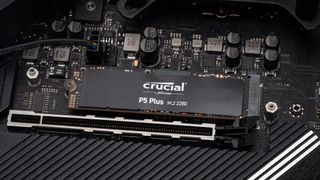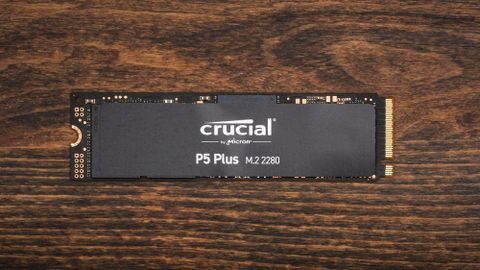Why you can trust Tom's Hardware
Crucial P5 Plus (1TB)

RATING: ★★★★
PROS
+ Competitive pricing
+ Hardware-based AES 256-bit encryption
+ Blacked-out aesthetics
+ 5-year warranty
+ Software suite
CONS
- Unimpressive sustained write performance
- High idle power consumption
- Less-than-average efficiency under load
OUR VERDICT
Aimed at gamers and creative professionals who want faster load times and more efficient workflow experiences, Crucial’s P5 Plus is a solid PCIe 4.0 x4 SSD that is priced well for what it has to offer.
Comparison Products
We dropped Crucial’s P5 Plus into the testing ring with a few of the fastest PCIe Gen4 SSDs that have landed in our test bed, as well as a few of the best PCIe Gen3 SSDs for comparison. PCIe Gen4 competitors include the Samsung 980 Pro, WD Black SN850, Sabrent Rocket 4 Plus. Our PCIe Gen3 competitors include the Samsung 970 Plus, WD Black SN750, Crucial’s own P5, and the SK hynix Gold P31.
Game Scene Loading - Final Fantasy XIV
Final Fantasy XIV Shadowbringers is a free real-world game benchmark that easily and accurately compares game load times without the inaccuracy of using a stopwatch.

Crucial’s P5 Plus wasn’t the most responsive of the bunch, but it delivered a respectable game load result overall, landing in the middle of our test pool. It outperformed the E18-powered Sabrent Rocket 4 Plus, but couldn’t keep up with the likes of the WD_Black SN850 or Samsung 980 Pro.
Transfer Rates – DiskBench
We use the DiskBench storage benchmarking tool to test file transfer performance with a custom dataset. We copy a 50GB dataset including 31,227 files of various types, like pictures, PDFs, and videos to a new folder and then follow-up with a reading test of a newly-written 6.5GB zip file.


When it came to copying around our large file folder, Crucial’s P5 Plus proved to be the slowest Gen4 SSD in our comparison, with a performance that was closer to that of the best Gen3 SSDs rather than a high-end Gen4 performer. On the other hand, in a pure read workload, reading back our large .zip file, the P5 Plus was much faster than the Gen3 competition. But it still trailed the Gen4 competitors.
Trace Testing – PCMark 10 Storage Test
PCMark 10 is a trace-based benchmark that uses a wide-ranging set of real-world traces from popular applications and everyday tasks to measure the performance of storage devices. The quick benchmark is more relatable to those who use their PCs for leisure or basic office work, while the full benchmark relates more to power users.






Surprisingly, in contrast to previous results, Crucial optimized the P5 Plus to handle PCMark 10’s workloads very well. Not only did the P5 Plus outperform the Sabrent Rocket 4 Plus, but also the Samsung 980 Pro. Only the WD_Black SN850 beat the Crucial in these workloads.
Synthetic Testing - ATTO / CrystalDiskMark
ATTO and CrystalDiskMark (CDM) are free and easy-to-use storage benchmarking tools that SSD vendors commonly use to assign performance specifications to their products. Both of these tools give us insight into how each device handles different file sizes.














The results from ATTO show the P5 Plus’s performance ramping wasn’t as consistent as its competitors across various block sizes, but it did trade blows with both the WD_Black SN850 and Samsung 980 Pro. In terms of write performance, however, it lagged behind the WD and Sabrent by a fair margin.
Furthermore, Crucial’s P5 Plus showed somewhat weak random IOPS performance in comparison to the other Gen4 competitors in Crystal Disk Mark, lagging even the PCIe 3.0 x4-based SK hynix Gold P31 by a few thousand IOPS at a QD of 1. Once we turned up the heat and hammered it with high queue depth workloads, peak random performance results were well ahead of most Gen3 SSDs, as well as the Sabrent in reads, but still lagged both the WD_Black SN850 and Samsung 980 Pro.
Sustained Write Performance and Cache Recovery
Official write specifications are only part of the performance picture. Most SSDs implement a write cache, which is a fast area of (usually) pseudo-SLC programmed flash that absorbs incoming data. Sustained write speeds can suffer tremendously once the workload spills outside of the cache and into the "native" TLC or QLC flash. We use iometer to hammer the SSD with sequential writes for 15 minutes to measure both the size of the write cache and performance after the cache is saturated. We also monitor cache recovery via multiple idle rounds.





As per the norm with Crucial, the P5 Plus takes advantage of the company’s dynamic write acceleration algorithm, which enables its fast write speeds, but once the SLC write cache is saturated, write speeds will degrade below that of rated levels. After writing roughly 100GB to our P5 Plus, write speeds degraded from 5.0 GBps to 1.3 GBps on average until full. After leaving the P5 Plus idle for some time, it managed to recoup a portion of its SLC cache in our following idle rounds, roughly 70GB in each and never varying.
Power Consumption and Temperature
We use the Quarch HD Programmable Power Module to gain a deeper understanding of power characteristics. Idle power consumption is an important aspect to consider, especially if you're looking for a laptop upgrade. Some SSDs can consume watts of power at idle while better-suited ones sip just milliwatts. Average workload power consumption and max consumption are two other aspects of power consumption, but performance-per-watt is more important. A drive might consume more power during any given workload, but accomplishing a task faster allows the drive to drop into an idle state more quickly, ultimately saving energy.
We also monitor the drive’s temperature via the S.M.A.R.T. data and an IR thermometer to see when (or if) thermal throttling kicks in and how it impacts performance. Bear in mind that results will vary based on the workload and ambient air temperature.




Ranking fifth place in our efficiency test, the P5 Plus’s efficiency lies closer to that of the Gen3 competitors than the Gen4 SSDs in our test pool. Crucial’s P5 Plus consumed more power than the P5, but with its faster performance it was a more efficient SSD under load. It also consumed over a watt of power at idle with APSM disabled, which is very high compared to the likes of the Samsung 980 Pro and SK hynix Gold P31.
At idle, the controller measured roughly 50C, but under load, and after transferring roughly 500GB to the SSD via multiple large file folder drags and drops at once, the P5 Plus’s controller measured only 78C, under its throttling limits and well below that of the original P5. Based on these results, we believe Crucial’s P5 Plus should remain cool in most applications.
Test Setup and Notes
| CPU | Intel Core i9-11900K |
| Motherboard | ASRock Z590 Taichi |
| Memory | 2x8GB Kingston HyperX Predator DDR4 5333 |
| Graphics | Intel UHD Graphics 750 |
| CPU Cooling | Alphacool Eissturm Hurricane Copper 45 3x140mm |
| Case | Streacom BC1 Open Benchtable |
| Power Supply | Corsair SF750 Platinum |
| OS Storage | WD_Black SN850 2TB |
| Operating System | Windows 10 Pro 64-bit 20H2 |
We use an Intel Rocket Lake platform with most background applications such as indexing, windows updates, and anti-virus disabled in the OS to reduce run-to-run variability. Each SSD is prefilled to 50% capacity and tested as a secondary device. Unless noted, we use active cooling for all SSDs.
MORE: Best SSDs
MORE: How We Test HDDs And SSDs
MORE: All SSD Content

Sean is a Contributing Editor at Tom’s Hardware US, covering storage hardware.
-
mikewinddale "You also get integrated power loss immunity due to the way Crucial programs the flash.."Reply
That's huge for a consumer drive in a 2280 form factor. -
Howardohyea Gotta love competition, they put out some impressive products.Reply
If I have to say 2020-2021 is one of the best years as far as competition is concerned. AMD v Intel is reaching an all time high and Nvidia is having competition.
Not to mention hard drives, you can snag a very capable drive for cheap prices these days -
plateLunch StorageReview was able to lock up their P5 Plus under heavy load. They had to power cycle their system to regain access. Did you see anything like that?Reply -
seanwebster Reply
Not thus far. It handled everything I threw at it thus far. Even after writing to the P5 Plus for more than 4x it’s capacity during our write saturation testing, it reformatted fine and benchmarked as if nothing happened.plateLunch said:StorageReview was able to lock up their P5 Plus under heavy load. They had to power cycle their system to regain access. Did you see anything like that? -
Soul_keeper Is the Nand actually running at it's rated speed of 1,600 MTps on this SSD ?Reply
Or is it doing the same as the Seagate 530 at 1,200 MTps ? -
seanwebster Reply
Your guess is as good as mine. Unfortunately, Crucial would not disclose this information.Soul_keeper said:Is the Nand actually running at it's rated speed of 1,600 MTps on this SSD ?
Or is it doing the same as the Seagate 530 at 1,200 MTps ?
